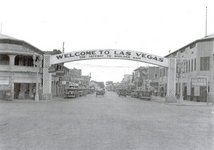Without further ado, let's go back in history, more precisely to the period around 700 AD. Even then, this area in Nevada was inhabited by the Paiute tribe. Once upon a time, the area of present-day Las Vegas was full of swamps with water and dense vegetation. Only later did it become an arid desert.

(Pajut tribe pictured)
Thebeginnings of Las Vegas
In 1829, a trading caravan led by Spanish merchant Antonio Armijo was commissioned to create a trade route - the Old Spanish Trail - between New Mexico and California. They crossed a tributary of the Colorado River to reach a valley that expedition member Rafael Rivera named "Las Vegas," which translates from Spanish as meadows or fertile fields.
On May 3, 1844, John Fremont was sent to the Las Vegas Valley, which was still part of Mexico at that time. He was sent there by President John Tyler to lead a group of scientists and spies for the United States Army Corps of Engineers, which was preparing for a possible war with Mexico. The war with Mexico eventually happened, after which the region became a territory of the United States with the signing of the Treaty of Guadalupe Hidalgo in 1848. John Fremont's diary of camping in Las Vegas Springs brought publicity to the area.

(Photo by John Fremont)
In 1855, a group of Mormon settlers from Utah began settling here. They built a 46-square-foot fort here, but due to growing tensions between Mormon community leaders, summer heat, and crop-growing problems, the settlers returned to Utah in 1857 and abandoned the fort. During the following years, the area remained uninhabited by Americans, but a small group of Paiute Indians still lived there. Less than 10 years later, on October 31, 1864, Nevada became the 36th state of the Union.

(Photo courtesy of Las Vegas Rancho)
The aforementioned fort was taken over in 1865 by Octavius Gass, who named the area "Los Vegas Rancho". The name had an altered spelling to avoid confusion with Las Vegas, New Mexico. The Paiute tribe declined in numbers and negotiated a treaty with the United States that ceded the area around the fort to the United States in exchange for the relocation and supply of food and agricultural equipment. In 1881, due to mismanagement and intrigue with the Mormon syndicate, Gass lost his ranch.
The First Railroad and the First Las Vegas
In 1902, the ranch was purchased by railroad magnate and U.S. Senator William Clark of Montana, who wanted to build the San Pedro, Los Angeles and Salt Lake Transcontinental Railroad to connect the cities. Clark bought the land and water rights to 809 acres of land for $55,000.

John Thomas McWilliams was an independent surveyor who was hired by the railroad in 1902 to survey the land they had purchased because they wanted to build a town there for their new station. In 1904, McWilliams purchased 32.4 acres of land west of the railroad from Clark and laid out a network of wide dirt roads. Then miners, construction workers, and railroad workers came to the area with their families and built homes. That same year, construction of the railroad across the Nevada River began.
Thus began the first Las Vegas, now known as McWilliams Townsite, where restaurants, taverns, pharmacies, grocery stores, blacksmiths, hotels, barbers, and even the first bank in Las Vegas began to spring up. When the railroad was completed, his town had more than 100 buildings.

But there was one serious problem
Las Vegas residents had to get their drinking or bathing water from various wells that were in the area. However, McWilliams did not get the water rights when he bought the land and that is where the whole problem began. Senator Clark decided to start advertising the land auction in May 1905 and assured the buyers that he would provide road maintenance, sewer and water after the land was purchased. He also refused to provide water to McWilliams Townsite.
Gradually, McWilliams' residents began to leave, and it took only a few weeks for his town to completely empty out. Clark's section thus began to grow, and on May 15, 1905, his section became the city of Las Vegas.

McWilliams' section began to decline and was destroyed by fire in September 1905. McWilliams refused to move out and insisted that the destroyed section of town be called "The Original Las Vegas Townsite". However, this never happened.
In the next few years, the first church was established in Clark's section, the Hotel Nevada (now the Golden Gate Hotel & Casino) opened, and the first telephone cables were installed on Fremont Street. A railroad maintenance yard was also established here, employing 400 to 800 workers. The biggest attraction in the city was Block 16, where liquor, prostitution, and gambling were legal. Thus, in 1909, Clark County was formed in Nevada, and the city of Las Vegas was incorporated as part of the county in 1911. The first mayor of Las Vegas was Peter Buol, who served as mayor from 1911 to 1913.

McWilliams in Oblivion
McWilliams died in 1941 before his section had sewers and paved streets. After his wife died, his house was torn down and everyone forgot about his first Las Vegas. Thus, all the fame and credit for the founding of Las Vegas is given to William Clark alone. Only the JT McWilliams Elementary School and nearby McWilliams Avenue, where a plaque commemorates his town, are left to remember McWilliams.

Source - wikipedia, las vegas review journal, pinterest, pbs.org, casino.org, lasvegasnevada.gov, lasvegassun.com, history.com, parks.nv.com, special.library.unlv.edu, historiclasvegasproject.com, hendersonhistoricalsociety.org, mojavedesert.net, lasvegaspioneertrail.com, historyfacts.com




